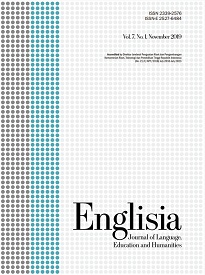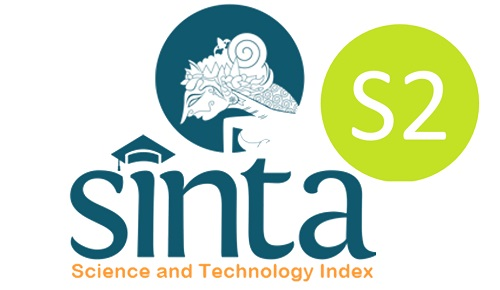Exploring a web-based interactive writing assessment WISSE: User experiences
DOI:
https://doi.org/10.22373/ej.v11i2.20386Keywords:
Academic writing assessment, AI-integrated website, EFL learners, User experienceAbstract
This paper aims to investigate the user experiences of Web-based Integrated Writing Assessment (WISSE) developed to help lecturers and learners provide and navigate feedback for academic writing in English. User experience is one of the crucial elements for product success and reception in Research and Development (R & D). Aspects of user experience highlighted in this study are web features, ease of use, and design. The participants involved were two lecturers and twenty-eight learners from the English Language Education and the English Literature study program at one of the prominent universities in Malang. At first, both learners and lecturers created a temporary account on the web prototype, and they were assigned two different roles: learners wrote and submitted a short argumentative essay on the application, and lecturers provided feedback on the essays through a personal comment box. At the end of the trial, both groups revealed their experience and inputs on the features, operation accessibility, and web design through questionnaires. To a large extent, both lecturers and learners were satisfied with the goal of the application to provide easy accessibility to assessing academic text. However, both groups agreed that more distinctive features should be added, along with a manual book and language switch feature, as it is attainable that the future users of WISSE will not be limited to EFL learners. The user trial results illustrate that while WISSE needs further development and revision, it exhibits proper performance and is prepared for large-scale use.
Downloads
References
Al-Qeisi, K., Dennis, C., Alamanos, E., & Jayawardhena, C. (2014). Website design quality and usage behavior: Unified Theory of Acceptance and Use of Technology. Journal of Business Research, 67(11), 2282–2290. https://doi.org/10.1016/J.JBUSRES.2014.06.016
Asikin-Garmager, A., Dowd, P., George, S., & Afifi, R. A. (2022). Integrating user experience evaluation in the development of a web-based Community Engagement Toolkit. Evaluation and Program Planning, 91, 102048. https://doi.org/10.1016/J.EVALPROGPLAN.2022.102048
Chen, H. R., & Tseng, H. F. (2012). Factors that influence acceptance of web-based e-learning systems for the in-service education of junior high school teachers in Taiwan. Evaluation and Program Planning, 35(3), 398–406. https://doi.org/10.1016/J.EVALPROGPLAN.2011.11.007
Chen, H. Y., & Liu, K. Y. (2008). Web-based synchronized multimedia lecture system design for teaching/learning Chinese as second language. Computers & Education, 50(3), 693–702. https://doi.org/10.1016/J.COMPEDU.2006.07.010
Degeng, P. D., Hamamah, H., Emaliana, I., & Hapsari, Y. (2022, August 5). Providing Feedback for a Large Writing Class: An Application Prototype for Integrated Academic Writing Online Assessment. https://doi.org/10.4108/eai.9-10-2021.2319684
Ellington, H., & Aris, B. (2000). A Practical Guide to Instructional Design (A. Attan, Ed.). University Teknologi Malaysia.
Gong, J. W., Liu, H. C., You, X. Y., & Yin, L. (2021). An integrated multi-criteria decision making approach with linguistic hesitant fuzzy sets for E-learning website evaluation and selection. Applied Soft Computing, 102, 107118. https://doi.org/10.1016/J.ASOC.2021.107118
Hamamah, H., Emaliana, I., Degeng, P., Hapsari, Y., Budiawan, D., & Gayatri, P. (2023). What Do Teachers Need? A Probe of Best Practice for Assessment as Learning in EFL Writing Class. Proceedings of the 2nd International Conference on Advances in Humanities, Education and Language, ICEL 2022, 07–08 November 2022, Malang, Indonesia. https://doi.org/10.4108/eai.7-11-2022.2329391
Hamamah, Hapsari, Y., Emaliana, I., Dian Danayanti Degeng, P., & Artikel Abstrak, I. (2020). Integrated Academic Writing Assessment Model to Support The Implementation of OBE Curriculum. http://journal.um.ac.id/index.php/jptpp/
Hamamah, Sahar, R. Bt., Emaliana, I., Hapsari, Y., & Degeng, P. D. D. (2023). Assessing The Feasibility of a Web-Based Interactive Writing Assessment (WISSE): An Evaluation of Media and Linguistic Aspects. JEELS (Journal of English Education and Linguistics Studies), 10(1), 177–197. https://doi.org/10.30762/jeels.v10i1.1093
Kaluarachchi, T., & Wickramasinghe, M. (2023). A systematic literature review on automatic website generation. Journal of Computer Languages, 75, 101202. https://doi.org/10.1016/J.COLA.2023.101202
Koltovskaia, S. (2020). Learner engagement with automated written corrective feedback (AWCF) provided by Grammarly: A multiple case study. Assessing Writing, 44, 100450. https://doi.org/10.1016/J.ASW.2020.100450
Lam, S. T. E. (2021). A web-based feedback platform for peer and teacher feedback on writing: An Activity Theory perspective. Computers and Composition, 62, 102666. https://doi.org/10.1016/J.COMPCOM.2021.102666
Lee, A. V. Y. (2023). Supporting learners’ generation of feedback in large-scale online course with artificial intelligence-enabled evaluation. Studies in Educational Evaluation, 77, 101250. https://doi.org/10.1016/J.STUEDUC.2023.101250
Li, A. W. (2023). Using Peerceptiv to support AI-based online writing assessment across the disciplines. Assessing Writing, 57, 100746. https://doi.org/10.1016/J.ASW.2023.100746
Liu, G. Z., Liu, Z. H., & Hwang, G. J. (2011). Developing multi-dimensional evaluation criteria for English learning websites with university learners and professors. Computers & Education, 56(1), 65–79. https://doi.org/10.1016/J.COMPEDU.2010.08.019
Lu, Q., Yao, Y., & Zhu, X. (2023). The relationship between peer feedback features and revision sources mediated by feedback acceptance: The effect on undergraduate learners’ writing performance. Assessing Writing, 56. https://doi.org/10.1016/j.asw.2023.100725
Mahmud, M. M., Freeman, B., & Abu Bakar, M. S. (2022). Technology in education: efficacies and outcomes of different delivery methods. Interactive Technology and Smart Education, 19(1), 20–38. https://doi.org/10.1108/ITSE-01-2021-0021
Seckler, M., Heinz, S., Forde, S., Tuch, A. N., & Opwis, K. (2015). Trust and distrust on the web: User experiences and website characteristics. Computers in Human Behavior, 45, 39–50. https://doi.org/10.1016/J.CHB.2014.11.064
Van der Heijden, H. (2003). Factors influencing the usage of websites: the case of a generic portal in The Netherlands. Information & Management, 40(6), 541–549. https://doi.org/10.1016/S0378-7206(02)00079-4
Vo, Y., Rickels, H., Welch, C., & Dunbar, S. (2023). Human scoring versus automated scoring for english learners in a statewide evidence-based writing assessment. Assessing Writing, 56, 100719. https://doi.org/10.1016/J.ASW.2023.100719
Wen, S.-F., & Katt, B. (2023). A quantitative security evaluation and analysis model for web applications based on OWASP application security verification standard. Computers & Security, 135, 103532. https://doi.org/10.1016/J.COSE.2023.103532
Weng, X., & Chiu, T. K. F. (2023). Instructional design and learning outcomes of intelligent computer assisted language learning: Systematic review in the field. In Computers and Education: Artificial Intelligence (Vol. 4). Elsevier B.V. https://doi.org/10.1016/j.caeai.2022.100117
Downloads
Published
Issue
Section
License
Proposed Policy for Journals That Offer Open Access
Authors who publish with Englisia journal agree to the following terms:
- Authors retain copyright and grant the journal right of first publication with the work simultaneously licensed under a Creative Commons Attribution License that allows others to share the work with an acknowledgement of the work's authorship and initial publication in this journal.
- Authors are able to enter into separate, additional contractual arrangements for the non-exclusive distribution of the journal's published version of the work (e.g., post it to an institutional repository or publish it in a book), with an acknowledgement of its initial publication in this journal.
- Authors are permitted and encouraged to post their work online (e.g., in institutional repositories or on their website) prior to and during the submission process, as it can lead to productive exchanges, as well as earlier and greater citation of published work (See The Effect of Open Access).









